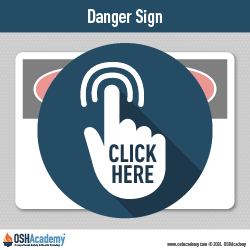Signs, Signals, and Barricades
Highway, road, street, bridge, tunnel, utility, and other workers for the highway infrastructure are exposed to hazards from outside and inside the work zone. Falls, electrical, struck-by, and caught between are the common hazards found in this type of work. Guidance for the set-up of work zone signs, barricades, flagging, etc. are found in the U.S. Department of Transportation's" Manual on Uniform Traffic Control Devices MUTCD (PDF)." The MUTCD is referenced in 1926 Subpart G. OSHA also provides guidance on it's Highway Work Zones and Signs, Signals, and Barricades webpage.
Signs for Construction
Signs are the warnings of hazard, temporarily or permanently affixed or placed, at locations where hazards exist.
Signs convey both general and specific messages by means of words or symbols and must be visible at all times when work is being performed, and must be removed or covered promptly when the hazards no longer exist.
Danger signs
Danger signs must be used only where an immediate hazard exists, and must follow the specifications illustrated in Figure 1 of ANSI Z35.1-1968 or in Figures 1 to 13 of ANSI Z535.2-2011, incorporated by reference in 1926.6.
Danger signs must have red as the predominating color for the upper panel; black outline on the borders; and a white lower panel for additional sign wording.
Caution Signs
Caution signs must be used only to warn against potential hazards or to caution against unsafe practices. They must follow the specifications illustrated in Figure 4 of ANSI Z35.1-1968 or in Figures 1 to 13 of ANSI Z535.2-2011, incorporated by reference in 1926.6.
Caution signs must have yellow as the predominating color; black upper panel and borders: yellow lettering of "caution" on the black panel; and the lower yellow panel for additional sign wording. Black lettering must be used for additional wording.
The standard color of the background must be yellow; and the panel, black with yellow letters. Any letters used against the yellow background must be black. The colors must be those of opaque glossy samples as specified in Table 1 of ANSI Z53.1-1967 or in Table 1 of ANSI Z535.1-2006(R2011), incorporated by reference in 1926.6.
Knowledge Check Choose the best answer for the question.
3-1. Which of the following is TRUE regarding the use of danger signs?
You forgot to answer the question!


